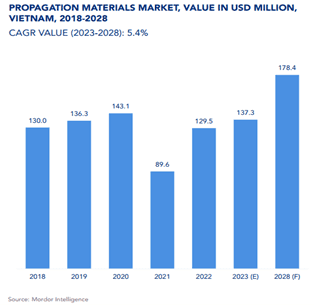In recent years, Vietnam's agriculture sector has witnessed substantial growth. A recent report on the Vietnam propagation materials market commissioned by the agricultural department of the Netherlands embassy in Vietnam and implemented by Mordor Intelligence provides valuable insights into the market dynamics, trends, and key factors influencing its trajectory. This article delves into the key findings of the report, shedding light on the current state and future prospects of the Vietnamese propagation materials market from 2023 to 2028. The scope of the report includes crop types, propagation methods, propagations materials and a propagation trade analysis.
Vietnam's agriculture sector
Agriculture remains an important part of Vietnam’s economic development. The country is rapidly developing and become one of Asia’s fastest-growing emerging economies. Agriculture accounts for almost 20% of GDP in Vietnam, and its projected to grow during forecast period due to rising government support, investments overseas and increasing demands. Major vegetable crops cultivated in the country include tomato, cabbage, cauliflower, potato and onions. In Vietnam, people are consuming vegetables due to the rising health awareness. As a result, the expenditure is rising, which is increasing the need for growth in production. Vietnam's floriculture sector is also gaining attention for its substantial potential, fueled by diverse climates, a youthful population, a large domestic market, and a growing middle-income consumer group. With a 15 percent annual growth in the past five years, the sector is projected to continue expanding at 10-15 percent annually in the next five years. The total area for flowers and ornamental plants has risen from 6,800 hectares in 2000 to 48.91 thousand hectares in 2021.
Market overview

In 2022, the Vietnamese propagation materials market was valued at USD 129.5 million, with a projected CAGR of 5.4% to reach USD 178.4 million by 2028. The Vietnamese market is segmented by crop type, propagation methods, materials, and trade analysis. The government's increased support for agriculture, exemplified by initiatives such as the Ministry of Agriculture and Rural Development's 10-year investment project, plays a pivotal role in driving market growth.
Market highlights
- Flowers and ornamentals largest crop type: Flowers and ornamentals dominated the market in 2022, capturing a substantial 76.7% share. The increasing demand for flowers and ornamental plants, supported by favorable climatic conditions and growing export demand, drives this dominance.
- Vegetative largest propagation method: Vegetative propagation is the primary method for plant propagation in Vietnam, with a notable uptick in recent years. Import data indicates a significant rise in the import of plant materials, from USD 100,063 thousand in 2021 to USD 166,668 thousand in 2022, reflecting the increasing market demand for vegetative propagation and driving market growth.
- Bulbs largest in propagation materials market: Bulbs/Bulbils dominate the market, starting at 26.8 million USD in 2018, maintaining 26.0 million USD in 2022, and projected to achieve a 5.3% CAGR from 2023-2028, reaching 34.5 million USD by 2028. This highlights their consistent significance and economic contribution to the market.
- Seed fastest growing propagation method: Seeds emerge as the fastest-growing propagation method, with a projected CAGR of 5.7% during the forecast period. Continuous seed research activities and the introduction of new varieties contribute to this growth.
- Young plant fastest growing propagation materials: Young plants (saplings) exhibit the fastest growth at a CAGR of 5.4%. These are crucial in flower cultivation and vegetable production, enhancing yield per hectare and reducing losses.
Market drivers
The primary driver for this growth is the unwavering government support towards agriculture. Initiatives like the 10-year investment project by the Ministry of Agriculture and Rural Development aim to strengthen floriculture, leading to an increase in the quantity and quality of propagation materials. Furthermore, investments in seed and vegetative propagation, coupled with the adoption of these methods, are propelling market expansion.
- Government backing: Vietnam's propagation materials market thrives on robust government support, evident in the approval of four Overseas Direct Assistance projects in 2022, infusing USD 840 million. The expanding vegetable harvesting area, reaching 1,002 thousand hectares in 2021, underscores the government's commitment to agricultural development.
- Investments in propagation: Growing investments in Vietnam's seed and vegetative propagation sector, driven by climate-resilient varieties by some leading companies and the government's target to double foreign agricultural investment to USD 34 billion by 2030, foster industry vigor and market growth.
- Adoption of vegetative propagation: Vietnam's agriculture witnesses a silent revolution with the rising adoption of vegetative propagation methods, promoting sustainable practices. Techniques like tubers, grafts, cuttings, and nodes gain popularity, promising sustained growth for the propagation materials market.
Market restraints
However, the market faces challenges, such as declining employment in agriculture. The shift towards more efficient vegetative propagation methods is impeded by a decreasing workforce in the sector. Strict legislation on certified seeds and plant propagation materials, coupled with climatic changes, further hinder market growth.
- Employment decline: World Bank data indicates a drop in agricultural employment from 32.6% in 2020 to 29.0% in 2021, affecting the production of propagation materials.
- Legislative hurdles: Stringent regulations on certified seeds and plant propagation, along with climatic changes, hinder the development of new materials, restraining market growth.
For those interested in a deeper understanding of market dynamics and trends, the full report provides comprehensive insights from 2023 to 2028. Please find the full report below.
Do you have any questions for the agriculture department please send an email to HAN-LNV@minbuza.nl. For the latest updates, news, funding opportunities and more follow us on Twitter @AgroVietnam.